
William Penn University is a private university in Oskaloosa, Iowa. It was founded by members of the Religious Society of Friends (Quakers) in 1873 as Penn College. In 1933, the name was changed to William Penn College, and finally to William Penn University in 2000.
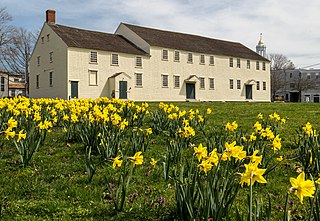
A Friends meeting house is a meeting house of the Religious Society of Friends (Quakers), where meeting for worship is usually held.

The Merion Friends Meeting House is an active and historic Quaker meeting house at 615 Montgomery Avenue in Merion Station, Pennsylvania. Completed about 1715, it is the second oldest Friends meeting house in the United States, with distinctively Welsh architectural features that distinguish it from later meeting houses. It is home to the Merion monthly meeting. The meeting house was declared a National Historic Landmark in 1999.

The Portsmouth Friends Meetinghouse, Parsonage, and Cemetery is a historic Friends Meeting House and cemetery of the Religious Society of Friends (Quakers), at 11 Middle Road and 2232 E. Main Road in Portsmouth, Rhode Island.

Upper Freehold Baptist Meeting, also known as Ye Olde Yellow Meeting House, is a historic church located on Yellow Meetinghouse and Red Valley roads in the Red Valley section of Upper Freehold Township near Imlaystown in Monmouth County, New Jersey. It is the oldest Baptist meetinghouse in the state. It was added to the National Register of Historic Places on April 21, 1975 for its significance in religion and exploration/settlement.

Appoquinimink Friends Meetinghouse, also known as the Odessa Friends Meetinghouse, is a very small but historic Quaker meetinghouse on Main Street in Odessa, Delaware. It was built in 1785 by David Wilson and added to the National Register of Historic Places in 1972. Members of the meeting, including John Hunn and his cousin John Alston, were active in the Underground Railroad and Harriet Tubman may have hid in the meetinghouse. Measuring about 20 feet (6.1 m) by 22 feet (6.7 m), it may be the smallest brick house of worship in the United States.
Aaron T. Simmons, most commonly known as A. T. Simmons, was an American architect. He designed 71 Carnegie libraries, numerous courthouses, schools, churches and other public buildings, and most of the houses in the Cedar Crest area of Normal, Illinois.

Iowa Yearly Meeting House-College Avenue Friends Church is a historic church building located in Oskaloosa, Iowa, United States. The Colonial Revival structure was designed by Bloomington, Illinois architect A. T. Simmons, and completed in 1913. As their membership declined, Quakers in Iowa decided to concentrate on a few fundamental tenets of their faith, but gave way on their traditional concerns about simplicity and restraint. This more elaborate building replaced a simple 2½-story, brick and stone structure that was completed in 1865. The building project was a cooperative arraignment that included the Yearly Meeting, the Monthly Meeting, and nearby William Penn College. Oskaloosa had been chosen as the location of the Iowa Yearly Meeting, or the denominational headquarters, because of its central location to where the Quakers settled west of the Mississippi River. The previous building had separate meeting facilities for men and women, and this one does not. That separation was no longer considered necessary by the time this building was built. It was listed on the National Register of Historic Places in 1996.
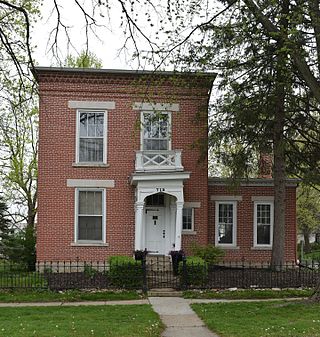
The Smith–Johnson House, also known as The Old Brick, is a historic residence located in Oskaloosa, Iowa, United States. It was built for William T. Smith in 1853, the same year he was elected as the first mayor of Oskaloosa. A lawyer, Smith was a native of Pennsylvania who settled in the town in 1848 and became county attorney the same year. In addition to his political and legal responsibilities he founded the first bank in town, and he was involved with other profitable financial ventures. He lived in the house until 1865 when Abijah Johnson, a Quaker merchant who moved to Oskaloosa to be a part of the flourishing Quaker communities here and in the surrounding areas. John Kelly Johnson, an attorney who served in the Iowa Senate, took over the house after his father's death in 1894.
The Spring Creek Friends Cemetery is a historic site located northeast of Oskaloosa, Iowa, United States. The approximately one-half acre plot of land contains an unknown number of burials with about 123 having plain markers that date from the 1860s through the 1890s. There is a network of pedestrian paths in the cemetery, and it is surrounded by a fence with concrete posts on the south, west, and north sides. The cemetery was founded about 1848 and continued to accept burials until about 1892. It calls attention to the earliest period of Quaker settlement in Iowa, which at that time was primarily a rural phenomenon. The Spring Creek Meeting was established here in the 1840s or the 1850s, and was the site of the first Iowa Yearly Meeting in 1863. The Spring Creek Meeting merged with the Center Grove Meeting in 1894 and formed the Oskaloosa Monthly Meeting. The meetinghouse subsequently moved into Oskaloosa, and burials here dropped off. The cemetery was listed on the National Register of Historic Places in 1996.
The Spring Creek Meeting House-H Street Mission was an historic building in Oskaloosa, Iowa, United States. The frame building was built sometime after an 1878 fire destroyed the original meeting house. It was relocated from its original rural location to this site in 1895. The Spring Creek Meeting was organized in 1844 outside of town. It calls attention to the movement of the Quakers from a rural setting to a central location in town. After its relocation it became a mission of the Oskaloosa Monthly Meeting. This illustrates the evangelical nature of the Iowa Yearly Meeting after the Schism of 1877, and their willingness to proselytize in order to rectify the decline in membership on the frontier. Such a move was an anomaly among Eastern Quakers. The architecture itself shows a shift in Quaker meeting houses in Iowa from structures that were long and low to this one with its high-pitched gable roof. It was listed on the National Register of Historic Places in 1996. The building has subsequently been torn down.
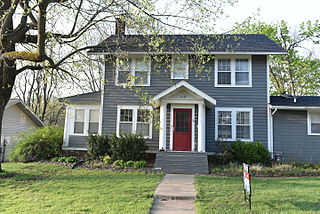
The Dr. William E. and Ethel Rosenberger Berry House is a historic residence located in Oskaloosa, Iowa, United States. The Berry's were Quakers and members of the faculty of William Penn College. He taught classical languages and served as Dean, while she taught French. They were among the first to settle in the Penn College Addition. The college platted and sold these lots, which in turn helped the institution financially survive. The Berry's bought several lots, and built their house on one of them. Their Colonial Revival house was built in 1924 by P.W. Sparks, a local contractor. It is a two-story, frame, single-family dwelling that features a side-gable roof, an enclosed front porch, and a solarium. It is the Berry's association with the school in the context of the Quaker testimony in Oskaloosa that makes this house historic. The house was listed on the National Register of Historic Places in 1996.
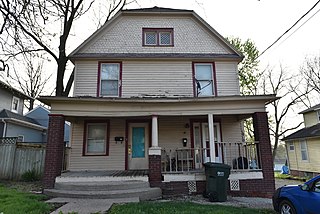
The Thomas J. Conover House is a historic residence located in Oskaloosa, Iowa, United States. Thomas J. Conover was a farmer who retired to town as a widower about 1910. He and his daughter Casa Mae Conover, lived here together while she worked at William Penn College. Between 1925 and 1951 she was a teacher of religious education, assistant registrar, secretary to the president, and the registrar. Single women who worked for the college rarely owned their own home. This suggests the difference in pay between men and women at the institution, even as it espoused gender equality. Casa had to live with her father and care for him in his old-age. Their Colonial Revival house was built about 1910. It is a two-story, frame, single-family dwelling that features a gable-end facade roof with hip-on-gable roof embellishment, fishscale shingles on the gable end, and a full-length front porch. It is the Casa Mae Conover's association with the school in the context of the Quaker testimony in Oskaloosa that makes this house historic. It was listed on the National Register of Historic Places in 1996.
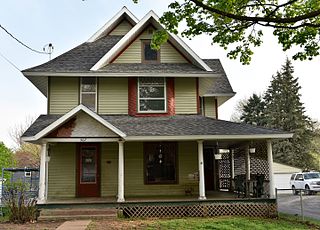
The William A. and Ida C. Johnson House is a historic residence located in Oskaloosa, Iowa, United States. The Johnsons, who were farmers, moved to town so that their children could attend Quaker schools there. This was typical of many Quaker families of that era. Other family members also boarded with them so they too could attend the schools. William Johnson also served on the William Penn College Board of Trustees and served as its president from 1915 through 1922. It was during his tenure that the Main Building was destroyed by fire and the college moved to its present location. This Queen Anne style house is a 2½-story, frame, single-family dwelling. It features a wrap-around full-width porch with a gable-end entryway and a bay window on the main facade. The house is capped with a complex roof of intersecting steeply-pitched gables. It is the Johnsons' association with the school in the context of the Quaker testimony in Oskaloosa that makes this house historic. It was listed on the National Register of Historic Places in 1996.

The Dr. William H. and Mae R. Klose House is a historic residence located in Oskaloosa, Iowa, United States. Dr. Klose taught German at nearby William Penn College, and was one of the longer serving faculty members. His dedication to the school helped it survive through its years of turmoil. They were also among the first to settle in the Penn College Addition. The college platted and sold these lots, which in turn helped the institution financially survive. This Colonial Revival style house is a 1½-story, frame, single-family dwelling. It features a side-gable roof, a facade gambrel dormer, and a bay window to the right to the main entry. It is the Klose's association with the school in the context of the Quaker testimony in Oskaloosa that makes this house historic. It was listed on the National Register of Historic Places in 1996.

The Dr. Ella Stokes House is a historic residence located in Oskaloosa, Iowa, United States. Dr. Stokes taught at William Penn College for four decades, and was one of the longest serving faculty members. She taught history, education, and philosophy during her career. Stokes lived in this modest house for more than half of the time she served on the faculty. She was one of the few female employees of the school who could afford to buy her own home, but she had to sell produce on the side and take in boarders in order to accomplish it. It is Stokes' association with the school in the context of the Quaker testimony in Oskaloosa that makes this house historic. It was listed on the National Register of Historic Places in 1996.

The Prof. Edgar H. and Irene D. Stranahan House is a historic residence located in Oskaloosa, Iowa, United States. Both Stranahans taught religious education at William Penn College, and he was one of the longer serving faculty members. Their daughter Esther taught religion at the college, which calls attention to family members from more than one generation who worked at the college. Edgar also served as master of ceremonies for the Oskaloosa Chautauqua in the 1920s. The Stranahans were among the first to settle in the Penn College Addition. The college platted and sold these lots, which in turn helped the institution financially survive. This two-story, single-family, frame dwelling is covered with stucco. It features vertical boards that define pilasters on the main facade, Moorish-type arch worked into the stucco, a front entry with pilasters that support a pedimented gable roof, and a solarium. It is the Stranahans' association with the college in the context of the Quaker testimony in Oskaloosa that makes this house historic. It was listed on the National Register of Historic Places in 1996.

The Pierson–Betts House is a historic residence located in Oskaloosa, Iowa, United States. The house was built by Lewis B. Pierson, the long-time Superintendent of Buildings and Grounds for William Penn College. He built this modest, single-story, brick house in the 1930s as a place that he and his wife Lilly could retire. Instead of moving in, they sold the house to Laura Betts who was the librarian at Penn from 1937 to 1942. She was one of the few single females employed by the college at that time who could afford to buy a house of her own. It is believed she could do so only with financial help from her elderly mother who moved in with her. After Betts moved out, other Penn faculty lived here. It is Pierson's and Betts' association with the college in the context of the Quaker testimony in Oskaloosa that makes this house historic. It was listed on the National Register of Historic Places in 1996.

The Spurgin Residence, also known as the Rice House, is a historic residence located in Oskaloosa, Iowa, United States. The 1½-story, frame, single-family house was built in 1895. From 1916 to about 1936 the structure was used as a "practice house" for domestic science instruction and student housing at nearby William Penn College. It is its association with the college in the context of the Quaker testimony in Oskaloosa that makes this house historic. The name "Spurgin Residence" was used by the college during its period of significance. It was listed on the National Register of Historic Places in 1996.

The President's Cottage is a historic residence located in Oskaloosa, Iowa, United States. From 1892, when it was built, to 1918 this structure housed the president of William Penn College. It highlights the school's improved finances at the time of its construction, the importance it placed on its leadership, and its association with the Quaker testimony in Oskaloosa, which makes this house historic. The placement of the house on a corner lot at the end of College Avenue gave the campus a linear feel in the "Yale Row" concept of college design.




















